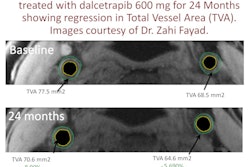People considered to be at low risk for coronary artery disease aren't so low-risk after all, according to early results from a large coronary CT angiography (CTA) screening study in Korea.
In one of the heftiest trials to date examining individuals at low risk of coronary artery disease, researchers from Seoul National University College of Medicine in Korea examined more than 8,000 low-risk patients and found lots of coronary artery plaque -- and, notably, noncalcified plaque that would not have been found using coronary artery calcium (CAC) scoring in their population.
The early results, presented last month at the 2010 RSNA meeting in Chicago, suggest that it may be time to broaden the list of potential candidates for coronary CT angiography.
Framingham limitations
The most common way of assessing the risk of coronary artery disease, the Framingham risk score, is a "simple and inexpensive test" that nevertheless comes with some major limitations, said Min Sue Lee from Seoul National University Bundang Hospital in her RSNA presentation. One limitation is that Framingham is population-based and does not assess an individual's risk of disease.
Moreover, in previous studies, Framingham risk scores have been shown to underestimate the risk of coronary artery disease in women and younger individuals, while overestimating the risk in Japanese-American and Hispanic men. Framingham often classifies medium-risk and high-risk subjects as low risk.
Another alternative, coronary artery calcium scoring with CT, is a strong prognostic tool, but it is blind to noncalcified plaques that pose risks of their own, Lee said in his RSNA presentation.
"It has been reported that more than half of plaques develop in low-risk patients," and "approximately 20% of cardiovascular events occur in the absence of any major risk factor," he said. For its part, CAC has a low predictive value in the low-risk group, "so we need to subdivide the population in the low-risk group," he said.
Lee's study aimed to evaluate the prevalence and plaque characteristics of coronary atherosclerosis in asymptomatic subjects classified as low risk according to the Framingham risk score.
A second goal was to assess coronary CTA's independent predictive power for significant stenosis (> 50 of lumen) of noncalcified subjects among asymptomatic individuals classified as low risk, Lee said.
The group examined 8,720 consecutive asymptomatic subjects who underwent both CAC scoring and coronary CTA at 64-detector-row CT (Brilliance, Philips Healthcare, Andover, MA) between 2006 and 2008. After excluding 752 subjects for various reasons including those outside the age limit of 20 to 80 years, and images with poor image quality or insufficient contrast enhancement, results from 7,968 subjects remained for analysis.
Framingham risk score assessment categorized participants into three risk categories:
- Low risk: n = 5,326 (66.5%)
- Intermediate risk: n = 1,636 (20.8%)
- High risk: n = 1,006 (12.8%)
Coronary CTA was performed following IV administration of 80 mL iodixanol (Visipaque 320, GE Healthcare, Chalfont St. Giles, U.K.) at 4 mL per second, followed by a 50-mL saline chaser for images acquired at scanner settings of 120 kV and 600-1,000 mA, Lee said. All images were analyzed by two experienced radiologists working independently and were reconstructed in 3-mm nonoverlapping sections. Calcium burden was calculated by measuring the area greater than 3 mm, Lee said.
The researchers weighed the effects of demographic risk factors (age, gender, body mass index [BMI], and blood pressure), as well as individual risk markers (hypertension, diabetes, hyperlipidemia, smoking, and family history of cardiovascular disease). Risk factors associated with laboratory findings included lipid profile (total cholesterol, triglycerides, and high- and low-density lipoproteins [HDL and LDL]), as well as glucose, Hb BUN/creatinine ratio, C-reactive protein, and brain natriuretic peptide (proBNP).
The results showed coronary atherosclerotic plaque, including noncalcified plaque, in significant numbers of patients deemed low risk based on Framingham scores.
|
Among 5,325 subjects classified as low risk, 793 (14.9%) had more than one plaque, while 84 subjects (1.6%) had significant coronary artery stenosis. Importantly, "442 subjects (0.8%) had significant stenosis caused by noncalcified plaque," Lee said.
Among the subjects classified as low risk who also had CAC scores of less than 100, a total of 691 (13.0%) had more than one plaque, 49 (0.9%) had significant stenosis, and 42 (0.8%) had significant stenosis caused by noncalcified plaque, Lee reported.
"Although asymptomatic populations classified as low risk, even with low CAC scores, have been regarded as a minimal-risk group, the prevalence of atherosclerosis plaques and significant stenosis were not negligible," Lee said.
The results might be useful for risk stratification in low-risk groups, he added, for example, in older males and individuals with hypertension or high LDL levels, offering more accurate risk evaluation compared to coronary artery calcium scoring alone.
Significant predictors for the presence of plaque included age, gender, hypertension, family history of premature cardiovascular disease, smoking, total cholesterol, HDL-cholesterol, and uric acid (all p < 0.05), Lee said.
Predictors of significant stenosis were age, gender, hypertension, family history of premature coronary heart disease, and LDL cholesterol (p < 0.05).
The researchers now plan to turn their focus toward determining what the results mean in terms of patient outcomes, Lee said in response to a question from session moderator Joseph Schoepf, MD, from the Medical University of South Carolina. To this end, they are analyzing the follow-up data to assess the predictive value of CTA across the study population, he said.
"It's impressive to see investigations of such large groups of asymptomatic individuals," Schoepf said of the study results. "These are unique populations that we find in Korea, and I think they will teach us a lot about what happens in atherosclerosis."
By Eric Barnes
AuntMinnie.com staff writer
January 7, 2010
Related Reading
Turf battles may be impeding growth of CCTA compared to MPI, December 28, 2010
CAD boosts new readers in diagnosing stenosis on CCTA, November 28, 2010
CONFIRM registry fills in CCTA evidence gaps, November 15, 2010
Supersized CONFIRM trial tackles coronary CTA and mortality, July 30, 2010
Cardiac model favors treadmill then CTA for low-risk patients, June 7, 2010
Copyright © 2011 AuntMinnie.com



















